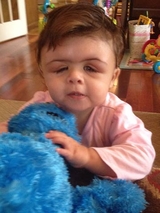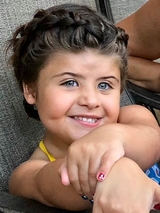Saethre-Chotzen Syndrome and Encephalocele: Elana’s Story

Immediately after Elana was born, her parents, Carly and John, noticed something unusual: “We saw a cluster of three bumps on the top of her head,” says Carly. The smallest was about the size of a pea, the other two a bit larger. An MRI quickly revealed that the bumps were brain matter. Then genetic testing showed that Elana also had a genetic syndrome that prematurely fuses the bones of the skull. “It was very scary,” says Carly.
Sac-like bulges of brain tissue are a rare condition known as encephalocele. Sometimes these are detected during prenatal testing, but Carly’s screening didn’t pick up anything. Elana would need surgery to repair the three holes. Her genetic condition, Saethre-Chotzen syndrome, prevents the skull from growing normally and affects the shape of the head and face. Surgery would be needed to separate the skull bones and place stainless steel springs in the seams to help increase the amount of room for the brain to grow.
“We did a nationwide search for specialists who were experienced with the combination of conditions she had,” says John. “We found four, and we talked to all of them.” A specialist in the Midwest suggested the family stay closer to their Maryland home. “They said, you don’t want an airplane ride between you and your doctor. They said, this is not going to be a quick fix.” Another specialist nearer to the family’s home wanted to do multiple surgeries at once, “And they didn’t explain why very well.” Then they came to Children's Hospital of Philadelphia (CHOP). “It was a completely different experience.”
‘We knew it was going to be OK’

Elana was 3 months old when they had a consultation at CHOP. “We were blown away by the kindness, the caring, the attention, the knowledge, the experience, the planning, and the explaining of what the plan would be,” says Carly. They met with Scott Bartlett, MD, an attending surgeon in the Division of Plastic, Reconstructive and Oral Surgery and Director of the Craniofacial Program. “We felt that he was an answered prayer. We knew it was going to be OK.” While they were there, Dr. Bartlett brought in Elaine Zackai, MD, the Director of Clinical Genetics, and Phillip “Jay” Storm, MD, Chief of the Division of Neurosurgery and Co-Director of the Neuroscience Center. “CHOP involved every discipline,” John explains.
At 6 months old, Elana underwent her first surgery, which removed the encephalocele and corrected the fusion of the bones in the back of her head. The distractors placed in her head had to be turned three times a day. Over the next three years, she had five more surgeries.

Now 10, Elana enjoys playing with her dogs, Jasper and Jessie. “I went to sleepover camp this summer and sailing camp and nature camp,” she happily reports. She is on the swim team, and her favorite subjects at school are writing and science. “I want to be a veterinarian!”
More surgeries in the future

Unfortunately, Saethre-Chotzen syndrome causes the sutures to grow back together, even after surgical correction had been performed. “We’re expecting she’ll need the next round or surgeries when she is 12 or 13,” says John.
Elana’s care team at CHOP has included specialists in otolaryngology (ear/nose/throat) and ophthalmology. Carly notes that pediatric psychologist Leanne Magee, PhD, worked with Elana on how to handle her surgeries and her scars and how to answer other kids when they have questions.

“Elana is very attached to CHOP,” says Carly. “She’s very comfortable there.” And Elana gives back. After receiving some small donations, she decided to do something special for other craniofacial patients: She makes tote bags and fills them with small gifts, then distributed them to children in the hospital.
Her parents report that Elana has one hobby that’s very specific to her experience: “She watches YouTube videos of medical procedures,” says Carly. “She knows that it’s part of her life.”